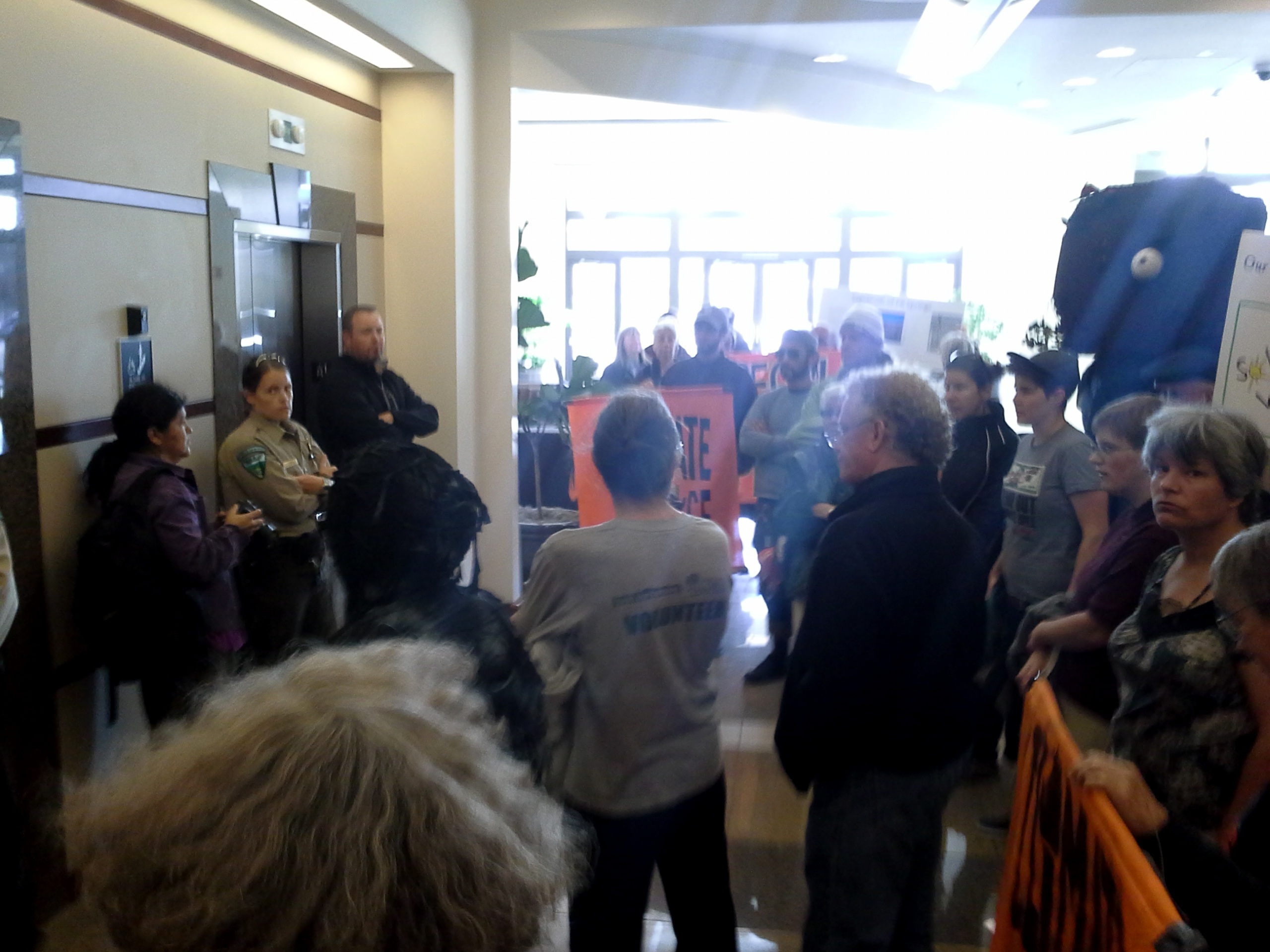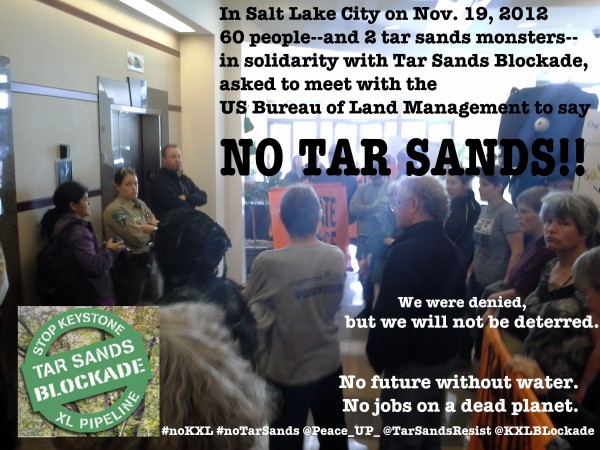Today in Salt Lake City, 62 people peacefully attempted to deliver a real environmental impact statement to the US Bureau of Land Management regarding BLM’s intentions to allow massive tar sands and oil shale developments in the Colorado River Basin. They were denied access to this public agency. This action was done in solidarity with Tar Sands Blockade, whose call for action has been answered this week in more than 40 communities. The people’s statement is below.
Because the People of Utah find the Bureau of Land Management’s decision to lease our 830,000 acres for tar sands and oil shale mining in Utah, Colorado, and Wyoming wholly irresponsible, as all available evidence points to the fact that these practices are extremely dangerous and destructive both to human health and to our environment, and as Utah’s economic wellbeing relies on the health of this environment, the People of Utah hereby oppose the Bureau of Land Management’s proposed decision and call for an immediate halt to the consideration of all sales or leasing of public lands for tar sands and oil shale mining.
We the People need water, not oil. Tar sands and oil shale mining would take water rights from communities, agriculture, and other purposes that are necessary for sustaining life. As communities, we can adapt to a life without oil. We cannot adapt to a life without water. We will not allow tar sands and oil shale mining to drain the Colorado, jeopardizing the lives of all those downstream including those of us in Utah.
We the People need water that is free from dangerous toxins. Tar sands mining puts compounds into the water that cause cancer, mutations, and birth defects. In Utah, we value the rights of all families and individuals—both here and downstream—to live healthy lives. We will not allow people to be poisoned for the sake of industry profits.
We the People know that the world already has five times more oil in reserve than would allow us to maintain a livable planet if we burned it. Mining tar sands would produce oil that cannot be used if we wish to ensure the very survival of our planet. We the People know that ceasing our use of oil poses substantial challenges, but that maintaining our survival is the only sane course of action.
We the People hold that Utah’s wilderness—our heritage and legacy—must not be destroyed for short-term profits. We the People of Utah rely on our majestic wilderness for our livelihoods, both directly and indirectly, and know that the future of our wilderness and ourselves is the same. We will not stand for the destruction of our nation’s wildest and most beautiful places.
Water Use
We the People hold that water is necessary for human life. Water is extremely limited in our arid region, so we must not squander it on water-intensive industrial practices like tar sands and oil shale mining. Oil shale requires four to five barrels of water for every barrel of oil produced, according to the Government Accountability Office, and tar sands requires similarly heavy water use. Making the tar sands and oil shale industries commercially viable would require tremendous amounts of water—hundreds of thousands of acre feet per year, as Western Resource Advocates explains. This water must be diverted from other purposes—i.e., taken from people—as Utah does not have extra water rights to give away. We must not deprive the people downriver, or inhabitants of Utah, of their access to water, and we must not deplete ecosystems of the water that allows them to exist.
Water Quality
Extracting bitumen from tar sands mobilizes dangerous compounds that are present in the ground, allowing them to move into the water supply, as Dr. William Johnson testified in Living Rivers’ legal challenge to U.S. Oil Sands’ right to dump wastewater into the land. Mining would contaminate our aquifers, rivers, and other water sources on which humans and wildlife alike rely.
In Alberta, Canada, communities downstream from the Athabasca tar sands are suffering rare forms of cancer such as cancer of the bile. The fish and game that First Nations communities relied on is contaminated by poisons and unfit for consumption. Wild animals are being found with tumors and mutations. Studies have confirmed that tar sands mining is responsible for these atrocities. In 2009, researchers of a major study published in Proceedings of the National Academy of Sciences found that the Athabasca River is contaminated with cancer, mutation, and birth-defect-causing compounds that are toxic in parts per trillion. We must not poison our bodies, the bodies of all the people downriver, and our wilderness with these deadly poisons.
Livelihoods
People come to Utah from all over the world to experience our beautiful wilderness. These visitors positively impact Utahns who work both directly and indirectly in the tourism industry, supporting local economies. For any jobs that tar sands mining allegedly would create, countless local jobs would be destroyed. Moreover, these local jobs provide a stable, ongoing source of income whereas tar sands mining jobs provide a temporary, unstable, and extremely stressful livelihood. We need only look to the massive problems facing mining towns such as Fort McMurry, Alberta, where inflation and inability to provide social services due to the influx of outside workers creates severe social instability.
We the People hold that renewable energy, complemented by major infrastructure and lifestyle changes, are the only viable means of ensuring a livable future for Utahns and all humans. Renewable energy has the potential to provide far more jobs than fossil fuel extraction and refining. As Cornell University Global Labor Institute states, “For every $1 million invested in renewable and clean energy, 16.7 jobs are created. By contrast, $1 million invested in fossil fuels generates 5.3 jobs.” Furthermore, as Cornell has found, the tar sands industry’s claims that it will create jobs are largely fabricated and primarily include extremely short-term work. We must strive for a real economic future for all Utahns, not cling to the false promises of an industry that sacrifices human wellbeing for its own profits.
Climate Change
Carbon emissions from tar sands mining are three times as high as those of conventional oil, making tar sands the dirtiest fuel available. Utah’s legal denial of climate change relies on blatant falsehoods, as eleven professors from Brigham Young University explained in a letter of protest. Utah’s denial of climate change is an entirely invalid argument that aims to sacrifice the rights of the people to a healthy planet for the right of industry to profit from the world’s last drops of oil. As Western Resource Advocates says, the BLM has entirely ascribed to this scientifically inaccurate stance on climate change by failing to even consider the impacts of climate change in its environmental impact statement. In doing so, the BLM invalidates the role of the EPA, which has asserted the overwhelming negative effects of greenhouse gases, failing to work together in partnership with the other federal agencies that are mandated with protecting human and environmental health. We must act based on the conclusions of the scientific community that greenhouse gases cause climate change, and cease consideration of production of the world’s dirtiest forms of fossil fuels.
We the People are tired of being told our own interests stand against those of the environment. Our health and the health of our environment are thoroughly intertwined. Our livelihoods and the lives of our ecosystems are intertwined as well. This is true for all people everywhere, but is particularly apparent in Utah, where our diminishing water levels and reliance on tourism points to the urgent need to protect our wilderness and water. For these reasons, We the People demand that the BLM cease all consideration of exploiting public lands for tar sands and oil shale production.
Bibliography
Alberta Health Services (2009). “Cancer Rate in Fort Chipewyan, Alberta, 1995–2006.” Retrieved
from http://www.albertahealthservices.ca/rls/ne-rls-2009-02-06-fort-chipewyan-study.pdf
Argonne National Laboratory and Bureau of Land Management. “Oil Shale and Tar Sands
Programmatic EIS: About Tar Sands.” Retrieved from http://ostseis.anl.gov/guide/tarsands/index.cfm
Bartis, James T. et al. (2005). “Oil Shale Development in the United States.” RAND.
Retrieved from http://www.rand.org/pubs/monographs/MG414.html
Brandt, Adam R. and Alexander E. Farrell (2007). “Scraping the Bottom of the Barrel:
Greenhouse Gas Emission Consequences of a Transition to Low-quality and Synthetic
Petroleum Resources.” Climatic Change, 84, 3-4: 241–263.
Brigham Young University professors (2010). Letter. Retrieved from
http://extras.mnginteractive.com/live/media/site297/2010/0204/20100204_024750_Legislature2.pdf
Department of Energy, Office of Petroleum Resources. “Fact Sheet: U.S. Tar Sands Potential.”
http://www.fossil.energy.gov/programs/reserves/npr/Tar_Sands_Fact_Sheet.pdf
Gillespie, Curtis (2008). “Scar Sands.” Canadian Geographic. Retrieved from
http://www.canadiangeographic.ca/magazine/jun08/feature_tar_sands3.asp
Physicians for a Healthy Environment (2010). “The Public Health Consequences of Utah’s Energy Policies.” Retrieved from
http://www.energy.utah.gov/government/strategic_plan/docs/publiccomments/uphe10152010.pdf
Science Daily (2009). “Untold Levels of Oil Sands Pollution On Athabasca River Confirmed.”
Retrieved from http://www.sciencedaily.com/releases/2009/12/091207151335.htm
Skinner, Lara and Sean Sweeney (2012). “The Impact of Tar Sands Pipeline Spills on
Employment and the Economy. Cornell University Global Labor Institute. Retrieved
from http://www.ilr.cornell.edu/globallaborinstitute/research/upload/GLI_Impact-of-Tar-Sands-Pipeline-Spills.pdf
U.S. Government Accountability Office (2010). “A Better and Coordinated Understanding of
Water Resources Could Help Mitigate the Impacts of Potential Oil Shale Development.”
Retrieved from http://www.gao.gov/products/GAO-11-35
University of Utah Institute for Clean and Secure Energy (2010). “Policy Analysis of Water
Availability and Use Issues for Domestic Oil Shale and Oil Sands Development.”
Retrieved from http://www.netl.doe.gov/technologies/oil-gas/publications/EPreports/FE0001243_TOR_23110_4.pdf
Western Resource Advocates (2010). “Fossil Foolishness: Utah’s Pursuit of Tar Sands and Oil
Shale.” Retrieved from
http://www.westernresourceadvocates.org/land/utosts/fossilfoolishness.pdf
Woynillowicz, Dan (2007). “Tar Sands Fever.” Worldwatch Institute. Retrieved from
http://www.worldwatch.org/node/5287


Leave a Reply